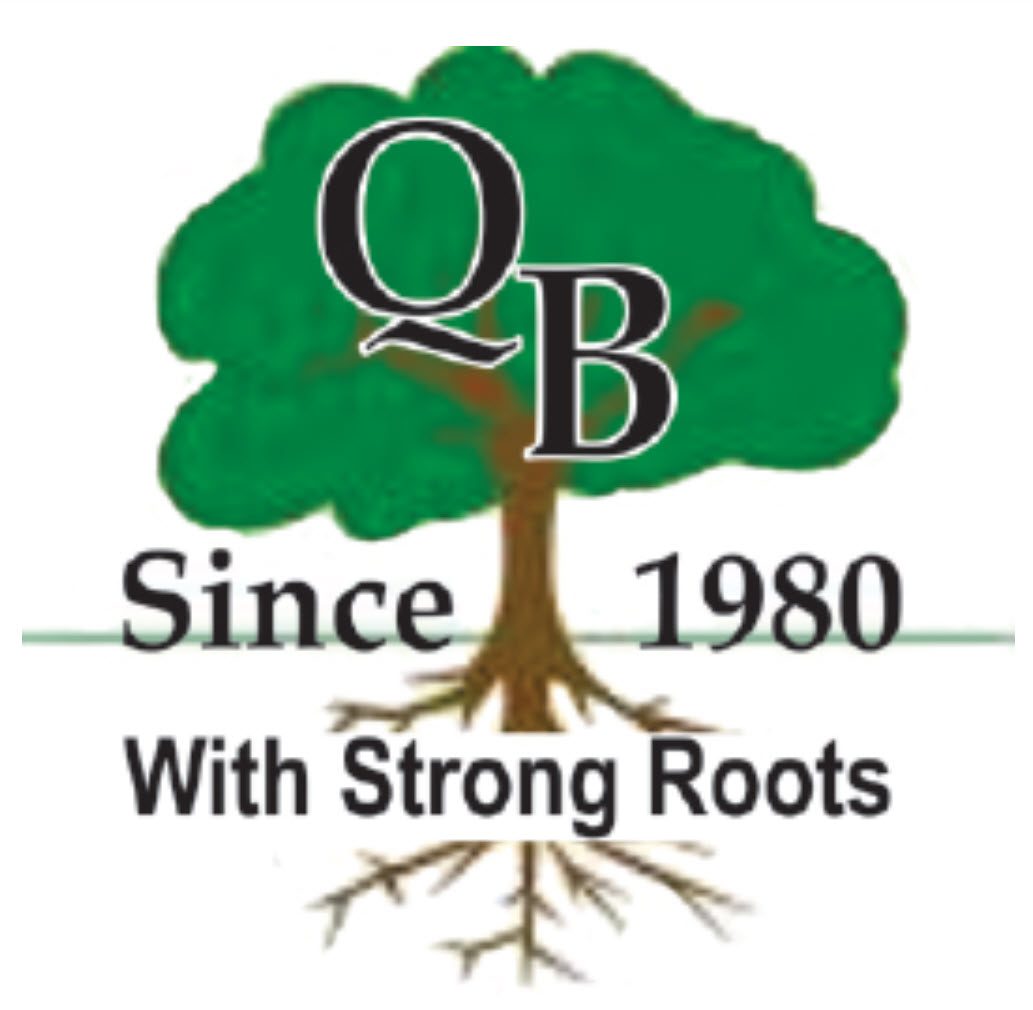- AGM 2018 & Great Moments in Genealogy
- Quinte Branch OGS Meeting – Postponed
- All About OGS
- Doors Open Quinte West 2018 Open House
- Genealogy Workshop: Getting Ready for Summer
- Introduction to GEDmatch Workshop
- The Loyalists: Recent Application Changes and Looking Beyond the Loyalist Ancestor
- Using Census Clues to Build a Blended Family
- All About Quinte Branch
- Making English Connections
- New Treasurer: Patrick Goodmurphy
- 2019 News
- 2018 News
- 2017 News
- 2016 News
- 2015 News
- 2014 News
- 2012-2013 News
- 2011-2012 News
- 2010-2011 News
- 2009-2010 News
- 2008-2009 News
- 2007-2008 News
- 2006-2007 News
- 2005-2006 News
Quinte Branch November Meeting
Presentation: Annual General Meeting 2018 (Great Moments in Genealogy)
Presentation by Quinte Branch
Article by John Carew
Photography by Georgette Green
November 17, 2018 was our last meeting for the calendar year. The November session has become a tradition of sorts, combining the Branch Council elections part of the Annual General Meeting (AGM) with an opportunity to explore and share important research events with each other.
On this occasion, we added something else of significance which also needs to be shared. Shortly after the 25th Anniversary of Quinte Branch in 2005, it became obvious that our cohabitation with 7th Town at the Marilyn Adams Centre in Ameliasburgh needed a fresh approach for something more practical. For close to 12 years, 1994 until 2006, 7th Town and Quinte Branch shared quarters in the MAGRC, both organizations growing their membership and libraries, and attempting to achieve their respective visions for success. To have effectively juggled collocation, cooperation and competitive spirit for 12 years together was a masterful achievement in itself, but that ever challenging scenario was alleviated to everyone’s benefit in the fall of 2005. Discussions between the Quinte West Public Library (QWPL) and Quinte Branch were entered into with a view to Quinte Branch taking up residence in Trenton. Over several months the move was considered, an arrangement was agreed to, and with the full support of the QWPL CEO and Chief Librarian Rita Turtle, Quinte Branch settled into its current accommodations here at 7 Creswell Drive, in the Quinte Genealogy Centre. Rita was invited to attend our deliberations on the 17th and we were pleased that she was available. Earlier this year we learned that Rita was going to retire at the end of 2018. So, armed with a great deal of respect and appreciation for Rita’s foresight and willingness to carve out a spot for Quinte Branch at 7 Creswell, 12 years’ worth of pride in our comfortable accommodations, and a wonderful working relationship with QWPL, our Chairperson, Terry Buttler, acknowledged Rita’s kindness to Quinte Branch and for her service to our community, and presented her with a bouquet of flowers and a Certificate of Appreciation from Quinte Branch OGS.
Following this, the AGM commenced, and the Election of Officers and the appointment of Committee Members proceeded. Minutes of this successful meeting have been written and released. The full text and import of those minutes will be published separately. Most of the Branch Council cadre remains as published for 2018. Significant changes for 2019 include: Angela Johnson UE has taken over as Chair from Vice Chair, Terry Buttler completed his term as Chair, and now holds the esteemed and highly sought-after title of Past Chair. Of further note, we had one volunteer step forward to be appointed as the new Webmaster for Quinte Branch. Wayne Wickson will take over that role in 2019 from Cheryl Levy. Wayne brings considerable experience in genealogy, training and IT to our group. A warm welcome to Wayne from all of us! Cheryl will continue with her ongoing support in Social Media and with her presentation skills. In addition, subsequent to the meeting, Heather Semper has volunteered to take on the Branch Membership responsibilities from Lynn Heale. Details of this late and very welcome update are being published separately.
After the AGM, we proceeded to Great Moments. This session of Great Moments was partly planned and partly spontaneous, and some focused spontaneity was what we were hoping for. No disappointment there! Prior to the meeting, in a couple of different discussions, I had mentioned that I had been helping out with adopted sibling family history research and was finding the whole process a little more challenging (perhaps just a little different) than what I was used to. As expected, I was asked to say a few words on the topic, in hopes that there might be one or two other members at the meeting willing to add to this topic. So, we started with my personal input on the subject. As it turned out, there were three of us at the meeting who have had some experience dealing with the additional challenges of tracing birth families of adoptees and ancestors of those birth families. Collectively, over the course of an hour, we heard about research on behalf of siblings, direct research experience by an adoptee, and additional cases of research for cousins, all for connection to birth families and those relevant ancestors. The objective at the outset was not to revel in the emotional issues and associated brick walls. Those realities were, nonetheless, significant and self-evident in the telling of the three stories. Rather, it was intended that we explore and acknowledge the research challenges, where they would be more difficult to achieve success, and perhaps would be more unique to the circumstances.
In a brief examination like this, it is impossible to be academically exact in our findings, given the small sample of participants involved. However, I think a few anecdotal opinions are worth noting for future reference. If this was the 1950s, we would not have the benefit of the internet, national and international online genealogical databases, more open government regulations with which to facilitate research to find biological parents and extended family members. At least equally important, and perhaps even most important is the achievement and availability of DNA testing for genealogical purposes. It is not the 1950s, and we do have all these items in our research toolboxes, and that is a good thing! It makes productive and accurate research possible, and in a compressed period of time compared to the 1950s. Despite all these good things, we are still hampered in our endeavours for all forms of genealogical research by privacy laws which, in addition to providing protection in matters of privacy for some, also serve to delay the finding of significant facts for others. In any event, the opportunities for success in this type of research are considerably faster and less cumbersome than in the past. That should be encouraging to all of us.
Completely unrelated (pun) to genealogical research, the final contribution to this edition of Great Moments was provided by Alex McNaught. The local author of A Place Called Walbridge informed us that he is closing in on a new book, soon to be released. This new book is predicated on personal letters and notes of a Canadian soldier from WW1 about his experiences and the trials and tribulations of “the war to end all wars”. We will likely want to get Alex back for a book release presentation when the opportunity strikes!
Merry Christmas to All and best wishes for 2019!
Quinte Branch October Meeting
Presentation: Postponed
Venue unavailable due to Municipal Elections
Quinte Branch September Meeting
Presentation: All About OGS
(The Ontario Genealogical Society)
by Steve Fulton UE, OGS President
Article by John Carew
Photography by Georgette Green
At mid-day, our Branch Chairperson and others had to break-off from the Doors Open festivities (see summary below) to set up for our afternoon meeting and host our guest speaker, Steve Fulton UE, the OGS President.
By 1 pm, the meeting commenced with a variety of announcements about upcoming events and items of genealogical interest, followed by the introduction of the speaker. Steve Fulton is a member in good standing of OGS, has recently been elected as President of OGS, remains the Chairperson of Niagara Branch, and is also serving as the IT Coordinator for OGS. Steve offered earlier this summer to come to Trenton to speak with our members about OGS in general, and to expound on his vision of OGS going forward. We were pleased that Steve agreed to make this September the timing for his visit, so as to be able to speak to and pass along his views as our new President to the benefit of Quinte Branch members, visitors and Doors Open guests alike.
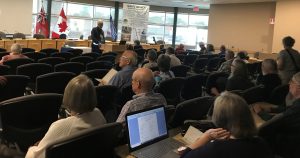 |
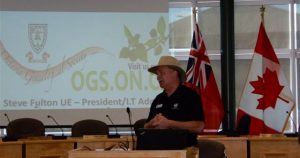 |
|---|---|
| Quinte Branch OGS September Meeting | Steve Fulton UE, OGS President |
The tone and subject matter of Steve’s address to our gathering was representative of the major points brought forward in the President’s official and publicly available words of welcome on the OGS website. For that reason and for economy of effort on my part, I have repeated his website welcome remarks below. In addition to these themes of organizational purpose, vision and mission objectives, resources and fellowship as family historians, I should add the following supplementary remarks. As long as I have known Steve, it has been clear that he was far more interested in developing the Society for future effectiveness in its roles supporting family history research, rather than simply fine-tuning the status quo. Further, his perspective on the Board of Directors for OGS primary role being that of supporting and serving the needs of the Branches and SIGs, is not only right-headed but is the most effective way ahead and confidence builder for “the boots on the ground”. Thanks, Steve!
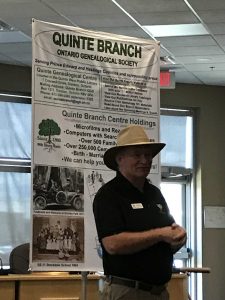 |
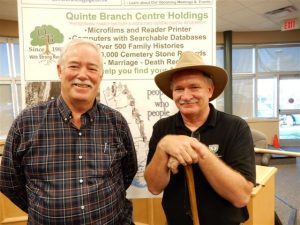 |
|---|---|
| Steve Fulton UE, OGS President at Quinte Branch |
Terry Buttler, Chair, and Steve Fulton UE, OGS President |
| The Ontario Genealogical Society – A Half-Century of Service to the Genealogical Community |
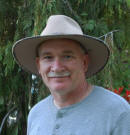 |
|---|---|
| Steve Fulton UE, OGS President |
As President of Canada’s largest genealogical society, I want to welcome you to drop in on our genealogy family through our website. The Ontario Genealogical Society is a vibrant, active community of family historians, operating at both the provincial level and at the grassroots local level through our 34 Branches and Special Interest Groups.
What do we do? We educate – through presentations, webinars, technical support, creation of publications and teaching materials, delivery of workshops and conferences; we advocate – through discussions with governing bodies at all levels of government, speaking out when cemeteries or heritage buildings are threatened, advising lawmakers about the importance of protecting our shared heritage; we preserve – by collecting the stories of Ontario families, by protecting fragile materials from harm, by digitizing documents to make them available to current and future researchers.
But mostly, we offer an opportunity for people pursuing the genealogy hobby to meet their peers, talk about their successes and challenges, learn from each other’s mistakes, and build on the successes of past generations of family historians to make the hobby easier and more rewarding for future generations. We get together in small groups in locations around the province; we get together once a year in a larger forum called “Conference” where the noise level in the hallways is equal to the enthusiasm of eager genealogists, and we get together using the internet – on Facebook groups, delivering webinars and presentations, and talking to our peers about our discoveries.
Our hundreds of volunteers devote tens of thousands of hours to projects such as The Ontario Name Index (“TONI”), cemetery recording and registration, writing articles for countless newsletters, speaking to organizations about how to begin recording their family history, teaching classes and groups about the finer points of genealogical research and Standards of Evidence, and in many, many more ways!
So, I invite you to drop in to our OGS website and discover the fascinating story behind your family, and how The Ontario Genealogical Society can help you discover yourself. If along the way you want to get in touch with someone, and you can’t find the right link on the website or have a simple question, please feel free to drop me a line at [email protected]. I love hearing from people who are excited by uncovering their roots.
Steve Fulton, UE, President
The Ontario Genealogical Society
Quinte Branch September
Doors Open Quinte West 2018 Open House
Article by John Carew
Photography by Cheryl Levy PLCGS
The annual Doors Open event in Quinte West is designed to showcase for residents and visitors a taste of what the Quinte area business, cultural and heritage community has to offer. As in past years, Quinte Branch welcomed guests to our Quinte Research Library throughout the day until QWPL closing at 4 pm. We focused our efforts on what our visitors came for: information about what our library has to offer to support family history research, advice on how to conduct research, and how to take full advantage of our resources to trace, document and learn about our ancestors. In a handful of cases during the day, some of our visitors who are active family historians were able to discover ancestors who had escaped their attention for several years. Others expressed interest in finally starting their research and perhaps even membership with Quinte Branch. It was a good day all round!
But wait. There’s more! The day also featured our September presentation in the afternoon. (See summary above)
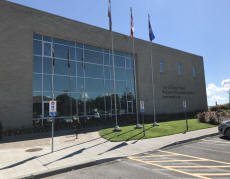 |
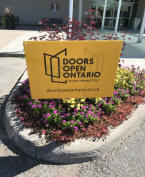 |
| Quinte West Public Library | Doors Open Quinte West 2018 |
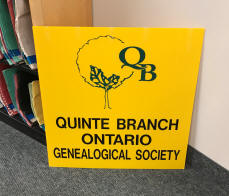 |
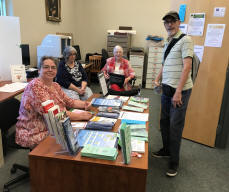 |
| Quinte Branch OGS | Angela Johnson UE, Vice-Chair; Lynn Heale, Membership; Lois Duggan, Social Hostess; guest |
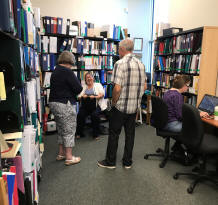 |
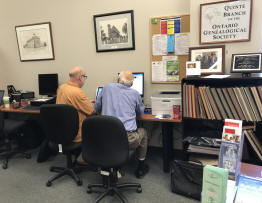 |
| Quinte Genealogical Research Library | Using Research Resources on Computers |
Quinte Branch June Meeting
Genealogy Workshop: Getting Ready for Summer
by Quinte Branch
Article by John Carew
Photography by Georgette Green
Slides by Cheryl Levy, PLCGS
For our final meeting before summer break, we decided on an Open Forum for our June meeting to provide opportunities to ask questions and share basic tips to sharpen our research skills. With summer just around the corner, we chose to examine a research trip to explore what could be involved in planning for such an event.
Cheryl Levy and Terry Buttler led the discussion, and just about everyone present participated with questions, suggestions or both.
First, we confirmed the benefits of planning for any research activity so as to maximize the value of your time spent and the overall success of the undertaking. In particular, if the event requires significant travel time and cost, getting the best value for your time and money is paramount. As for the research activities, we discussed the three most common research events: a family visit, cemetery visits, and a visit to a repository of various types.
Recognizing credit where credit is due, Cheryl prepared a set of slides and research items to represent the main issues to consider, in order to cover as much ground as possible in the time available. The slides were invaluable in generating ideas, dialogue and a very active learning session. Thanks, Cheryl!
You can review the slides below, and apply the topics to any and all of your future research trips.
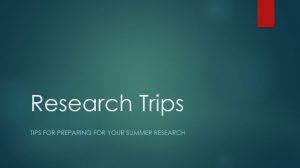 |
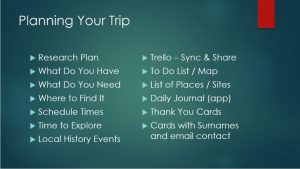 |
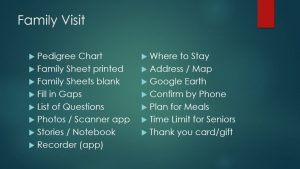 |
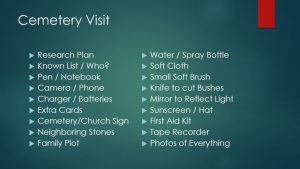 |
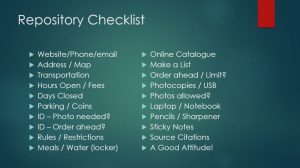 |
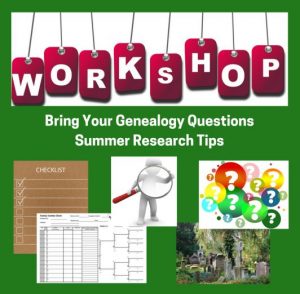 |
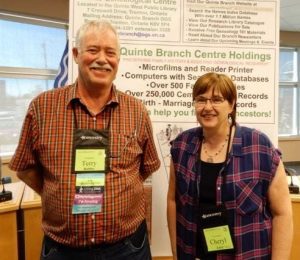 |
| Genealogy Workshop lead by Terry Buttler, Chair and Cheryl Levy, Social Media Coordinator |
Quinte Branch May Meeting
Digital Presentation: Introduction to GEDmatch Workshop
Presented by: Blaine Bettinger
Article by John Carew
Photography by Georgette Green
Beginning around the mid-1990s, online genealogical research and genealogical DNA testing entered the realm of family history research. They were not intended to outright replace existing tools and methodologies. There was, however, a high level of expectation of early adoption of these new realities which would be a boost to the family history phenomenon. Call that a good guess! As the opportunity to get DNA testing accomplished became a reality, the initial assault and effort was on testing, by several different companies, with limited concern or thought for cross-platform analysis for the different customer cadres. Eventually, steps have been taken to address this shortcoming, and regardless of platform all autosomal test results can be analyzed in one location regardless of test company: Ancestry, 23 and Me, (Family tree DNA, etc.). A big step forward! In the current term, the DNA website GEDmatch is a go-to site, in order to compare your Raw DNA data for matches determined at most if not all test sites. The GEDMatch website can be intimidating, so this lecture was designed as a primer, with a look at some of its basic but very important tools that genealogists can utilize in their research. The presenter provided a look at the ethnicity tools, the One-to-Many tool, the One-to-One tool, and the X One-to-One tool, basically to equate what researchers would expect to see on their test results, repeated in the larger integrated database on GEDMatch.Blaine stepped us through the above tools, with results variably equating to the test results offered in your DNA test scenario, but with the added value of the cross-platform database (a bigger cousin pool). At the moment, I am enjoying a slower learning curve, still working with the tried and true research methods plus the insights to be gleaned from DNA test results, ethnicity reporting and DNA matching. I’ll likely venture into GEDMatch opportunities at some point when the need arises, but for now, I have enough on my plate to keep me busy. See you in the big database eventually!
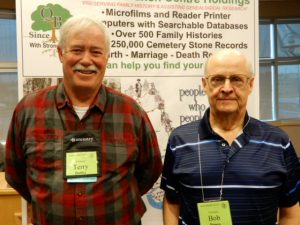 |
| DNA Questions following the presentation were answered by: Terry Buttler, Chair and Bob Dawes, IT & Databases |
Quinte Branch April 21 Meeting
UEL Workshop: The Loyalists:
Recent Application Changes and Looking Beyond the Loyalist Ancestor
Presented by: Peter Johnson UE & Angela Johnson UE
Article by John Carew
Photography by Georgette Green
On Saturday, April 21, 2018, Peter Johnson UE and Angela Johnson UE led a workshop on the general subject of United Empire Loyalists. If one had been considering applying for UEL standing and wanted to hear about, and learn more about, the research universe and collegial enterprise that Loyalists reside in, you would have wanted to be present as part of this group of Loyalist enthusiasts for the afternoon with Peter and Angela Johnson. Peter and Angela are both long service members of the United Empire Loyalists’ Association of Canada (UELAC), and the Q&A provided lots of opportunity for questions about the presentation and more general issues in the UEL realm.
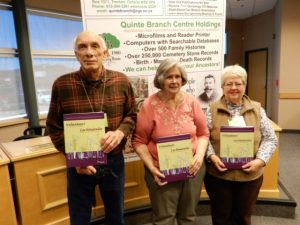 |
| 2018 OGS Service Awards: John Carew (Past-Chair) – 5-year pin; Lynn Heale (Membership) – 15-year pin; and Debb Walker (Publicity) – 5-year pin. Missing in photo: Debbie McDonald (Secretary) – 5-year pin; Richard Hughes (Research) – 10-year pin; and Carole Foshay – 10-year pin. |
Prior to the presentation, Angela took the opportunity as Vice Chair to congratulate members of Quinte Branch Council on their recent Ontario Volunteer Service Awards. The recipients were Richard Hughes, Lynn Heale, Carole Foshay, Debb Walker, Debbie McDonald and John Carew.
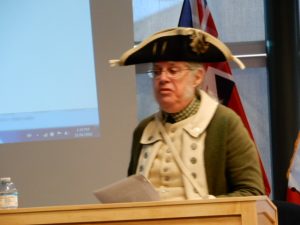 |
| Peter Johnson UE in New Jersey Volunteers’ Uniform |
It was made clear during the presentation that the application process was not a simple fill-in-the-form exercise, then wait for your UE Certificate to arrive in the mail. No, this process is intended to be exacting in the matter of genealogical proof for each generation, requiring a primary record of birth, marriage or death for each person/ancestor involved in the proof requirement. Where primary records might be lacking, several other types of documents could be invoked in support of the genealogical proof requirement and be presented for consideration. Such documents as Wills, church records of birth, marriage or burial/death, military records, and others could be considered. It is equally important to know that this road to UE recognition, as tedious and challenging as it might seem, is not intended to be travelled alone. In addition to the application, there is also the matter of joining a branch of the UELAC at the outset of your journey either near your place of residence or that of the ancestor whose Loyalist status you intend to claim. This accomplishes two things: a valuable measure of assistance in achieving a successful outcome, and in establishing a bond with the members of your branch and the UELAC itself. All of the genealogical nitty-gritty will seem so much less challenging as a result of embracing the help and guidance that is willingly available. Besides being careful to establish the thorough but friendly and helpful nature of the UE application, Peter and Angela spent a considerable amount of time, showing several of the period military unit uniforms from the Revolutionary War and afterward, including the New Jersey Volunteers which Peter wore for the occasion.
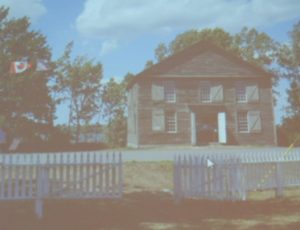 |
| Old Hay Bay Church |
They also included a striking photograph of the Old Hay Bay Church, 1792. The mere thought of a building still standing, and so closely connected to the Loyalist migration to Canada prior to 1800 is inspiring, whether you have UEL connections or not.
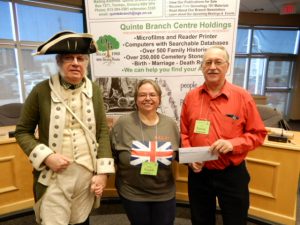 |
| Our Loyalist Workshop presenters: Peter Johnson UE (Cemeteries) and Angela Johnson UE (Vice-Chair). Thank you by Patrick Goodmurphy (Treasurer). |
Peter and Angela, thanks for the historical and genealogical tour of the UE application process, and the very visible and sincere encouragement to those eligible to join who needed a little nudge.
Quinte Branch March 17 Meeting
Presentation Topic:
Using Census Clues to Build a Blended Family
by Cheryl Levy, PLCGS
Article by John Carew
Photography by Lynn Heale
Census records provide many clues to further our research. Each column in each Census return contains valuable and specific information. This is especially important to remember when endeavoring to identify all the members listed in a specific household on census night. However, it is worth asking the question, “do all the members actually belong to the same family?” “Are the recorded relationships accurate?” “Can we trust the surnames given for each person?” “Who are the additional people listed?” These are some of the reality checks necessary to investigate if we really want to conclude our research with reasonably factual information to record in our family trees. The fact is, even with the best of intentions in completing census returns, like many other forms of research records, there are mistakes in spelling and numerical representation, incomplete facts, false information which spawns false assumptions, and poor handwriting by the enumerator and frequently, shoddy recollections by the inhabitants of each domicile. To demonstrate, Cheryl employed an interesting blended family case study through the period 1861 to 1911 to help us learn how to uncover the details needed to explore additional documents to confirm accurate identities and related facts. The process, as usual, started out by examining census records, questioning returns that appeared to be “doubtful” or in conflict with known facts. Then use of alternative methods and clues to interrogate census databases was employed to unearth more useful and supportable information from other record sets to complete each problem area. After a series of efforts aimed at solving each mystery one at a time, Cheryl completed the steps that were required to build this blended family, successfully placing the many household members in the “shown to be correct” family groups. By gleaning census clues, following leads in various databases, and remaining focused on the objective, we were soon able to understand the family history stories behind how and why certain family members came to be in particular households together on various census nights, but were in fact, as individuals, members of different family groups in the larger blended family.For the novice researcher, this was a very valuable learning experience which will save lots of anguish and unforeseen errors. For the experienced researcher, Cheryl’s talk was welcome confirmation that the lessons learned over the years were right and game savers. Cheryl is a graduate of the National Institute for Genealogical Studies, with a focus on genealogical research and education. She is a member of Quinte Branch, OGS, where she holds the executive position of Social Media Coordinator.
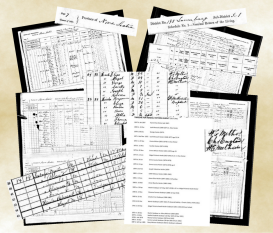 |
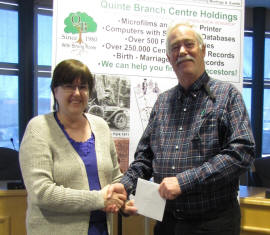 |
| Cheryl Levy, PLCGS and Terry Buttler, Quinte Branch Chair |
Quinte Branch February 17 Meeting
Presentation Topic: All About Quinte Branch
by Quinte Branch Council Members
Article by John Carew
Photography by Georgette Green
Prior to the presentation, the Chair made some administrative announcements including a reminder of the early bird registration deadline of February 28 for OGS Conference 2018 at Guelph, and the treasurer introduced and explained the budget for 2018 and successfully sought budget approval from the members present. The membership coordinator advised the assembly that the membership thus far for 2018 was 231 including family members. Our OGS President, Patti Mordasewicz, arrived just in time for the presentation, a visit to Quinte Branch that she had been looking forward to for some time. In a thank you email to our Chair, Patti said she appreciated the warm welcome and the opportunity to share ideas and the afternoon with us.
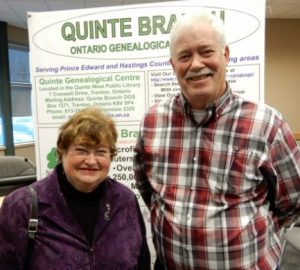 |
| OGS President, Patti Mordasewicz and Terry Buttler, Quinte Branch Chair |
The presentation was emceed by Terry Buttler, and the speakers were Cheryl Levy, Bob Dawes, Lynn Heale and John Carew. Having got our Quinte Branch website back up and running after almost 2 months of downtime, we decided to focus our attention on the website menu and its myriad parts as a useful refresher. That turned out to be a good decision and many thanks to Steve Fulton for standing up the website on the OGS server. Our new URL is: https://quinte.ogs.on.ca. Cheryl provided an excellent overview of the Branch Information, Library and Research, Publications, and Genealogy 101 subsections. She also covered the Branch’s very successful Facebook page and the benefits of Pinterest and how it can be used in genealogy research to keep track of websites for future use. Bob provided a practical live demonstration of the Names Index Database, both the online version and the computer-based version in the library. He also demonstrated the new OGS membership signup system for joining and renewing membership. Lynn explained the purpose of the online Surname Interest List service, how to make a request, and how to determine who to contact, using the Provider and Surname PDF files. John reviewed the Library Catalogue and discussed its use as both a library management document and a research tool. The website menu on the homepage is available always, and it is recommended to all to scroll through the menu occasionally to check for new services and features, and to remind ourselves of the wealth of information available behind the Quinte Branch OGS website.
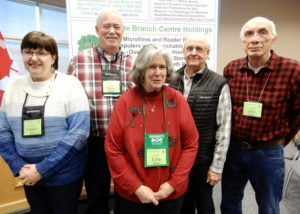 |
| Cheryl Levy, Webmaster & Social Media Coordinator; Terry Buttler, Chair; Lynn Heale, Membership Coordinator; Bob Dawes, IT & Databases; and John Carew, Past Chair |
Quinte Branch January 20 Meeting
Crouse-Wanamaker Lecture:
Presentation Topic: Making English Connections
by Bob Dawes, Quinte Branch
Article by John Carew
Photography by Georgette Green
For several years now, Quinte Branch has taken the opportunity to pay homage to the 1980 Charter members of the Branch and, in particular, the early leadership and mentoring of the Branch by Gordon Crouse, and Laurel and Mildred Wanamaker. This year was no exception, and the chosen Crouse Wanamaker lecturer was Bob Dawes. Bob is our Database and IT coordinator, an integral member of the Quinte Branch Library Committee, an accomplished researcher and a well-recognized and appreciated speaker on the genealogy circuit. Making English Connections is the second such lecture on this theme, following a previous and similar undertaking by Bob on the topic of researching Scottish Ancestors. The presentation was comprised of five elements including: English County and Parish structure, Parish, Civil, Census and other pertinent records, Societies and the many ways that they can help with research objectives, a review of close to 20 different paid and free websites which be used to conduct research into these various records and a case study to demonstrate methodology and results.It was evident that there were many choices of websites available to accomplish the task of fleshing out one woman born in 1905 in Doncaster, Yorkshire, England and findings vital records for her, her husband, their son and his wife. However, Bob was successful in stepping us through this process, using only free websites with very good results. As a much-appreciated bonus for those of us who attended the lecture, Bob provided a copy of his website list complete with a summary of the record types which could be discovered. It will be put to good use.
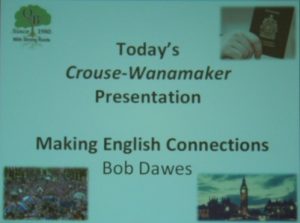 |
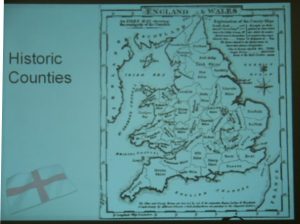 |
Quinte Branch Council 2018 News
Welcome New Treasurer: Patrick Goodmurphy
Photography by Georgette Green
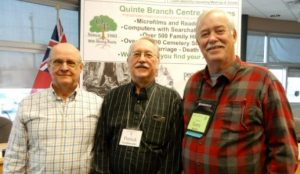 |
| January Presenter: Bob Dawes, IT & Databases; Welcome to Patrick Goodmurphy, Treasurer; and Terry Buttler, Chair |
